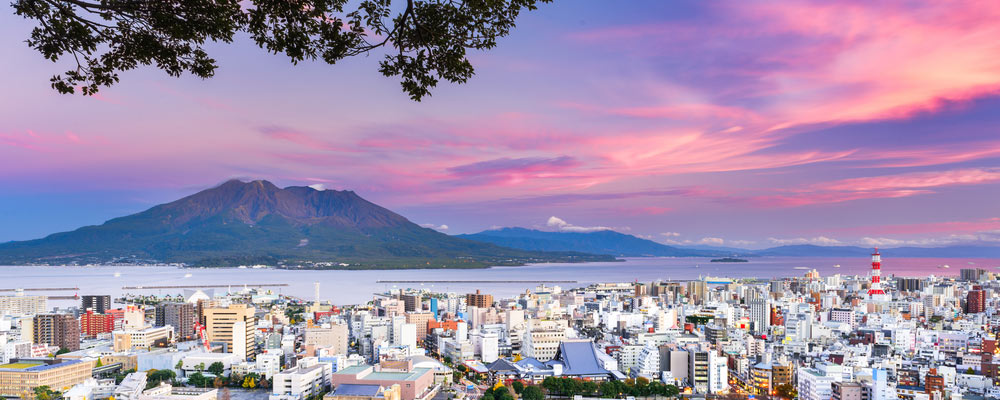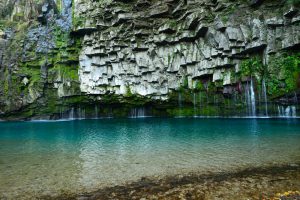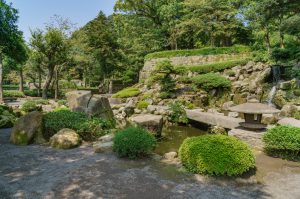Kagoshima Travel Guide

 Overview
Overview
Situated on the southwestern tip of the island of Kyushu, Kagoshima is the largest city and capital of Kagoshima Prefecture. It earned the nickname “Naples of the Eastern World” because of its location on the bay, humid subtropical climate, and presence of an active volcano, Sakurajima, which last erupted on 5 February 2016 and continues to emit large volumes of volcanic ash.
 When To Go
When To Go
- Summertime (June – August) in Kagoshima is warm, with daily temperatures in the high 20s. The months of June and July are the wettest of the year, so remember to take raincoats and umbrellas when sightseeing.
- In autumn (September – November), it slowly becomes cooler (with temperatures between 10 and 20 degrees), and rainy days become less frequent.
- In winter (December – February), Kagoshima is cool (day temperatures are between 5 and 10 degrees) and dry (precipitation of less than 100 mm).
- During spring (March – May), the weather is still pleasant (average day temperatures of around 15 degrees) with a few rainy days here and there.

Dynamic Ogawa waterfall

Japanese landscape
 Things To See
Things To See
Visit the Senganen Garden
The Senganen Garden is a Japanese-style garden that was built in 1658 by the powerful feudal family, Shimazu, during the Edo Period. It features a bamboo grove, shrines, streams, ponds and borrowed sceneries of Kagoshima Bay and Sakurajima. In the middle of the garden complex stands the Iso Residence, which served as the Shimazu Clan’s main residence after the feudal period.
Go to the Kagoshima Aquarium
Inaugurated in 1997, the Kagoshima Aquarium is a seven-storey building situated adjacent to the Kagoshima Port. It offers a variety of attractions, including the large Kuroshio Tank, which serves as home to several schools of fish, a massive whale shark and rays. It also has exhibition areas dedicated to mangroves, coral reefs, sea otters and other marine life.
Tour the Reimeikan Museum
For information on Kagoshima’s culture and history, a tour of the Reimeikan Museum is a must as it houses a wide collection of exhibits that tell the region’s story, starting from ancient times and continuing to the present. It stands on the former Kagoshima Castle site, with portions of the stone walls and moats still surviving.
 Where To Explore
Where To Explore
- Shiroyama Park – Found in central Kagoshima, Shiroyama Park is built on Mount Shiroyama and offers amazing views of the downtown area, Sakurajima and Kagoshima Bay. It can be reached by taking the City View Bus from Kagoshima Chuo Station to Shiroyama Observatory.
- Sakurajima – The most important landmark of Kagoshima, Sakurajima is an active volcano that constantly discharges smoke and produces small eruptions several times a day. At a height of 1,117 metres, it is the most prominent symbol of the city and is a popular tourist attraction. Around the volcano there are hiking trails (Nagisa Lava Trail), onsen (Magma Onsen), foot baths (Nagisa Park Foot Bath), observation points (Arimura, Yunohira, and Kurokami), and a dinosaur park.
- Kagoshima Fish Market – Located in central Kagoshima, the Kagoshima Fish Market is a smaller version of the Tsukiji Market of Tokyo. It is home to many shops and stalls that sell a wide selection of fresh local produce. Its operating hours start very early in the morning and its atmosphere becomes more vibrant and bustling throughout the day. Guided tours are available for those who want to learn about the market’s history and feast on a sushi breakfast at the market’s specialty restaurants.

Tenmonkan – ©JNTO

Sakurajima Volcano
 Getting Around
Getting Around
Kagoshima is served by two tram lines, trains and buses. For easy access to the city’s top attractions, the City View Buses provide fast and direct connections to the most popular spots, starting at Kagoshima Chuo Station. A one-way bus ticket costs 190 yen, and a one-day bus pass costs 600 yen.












